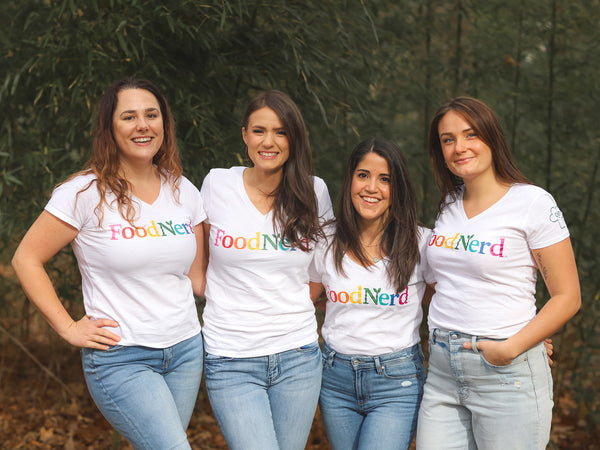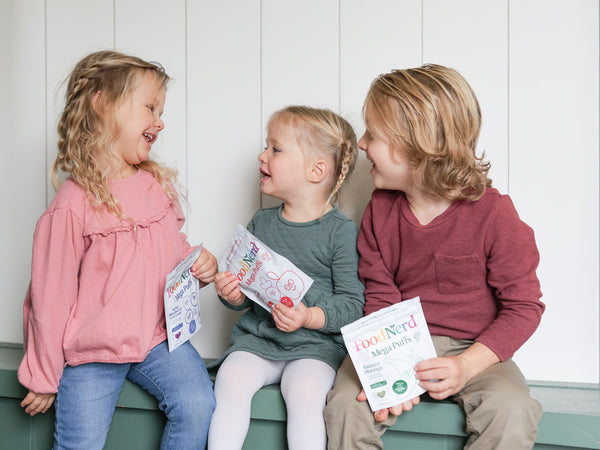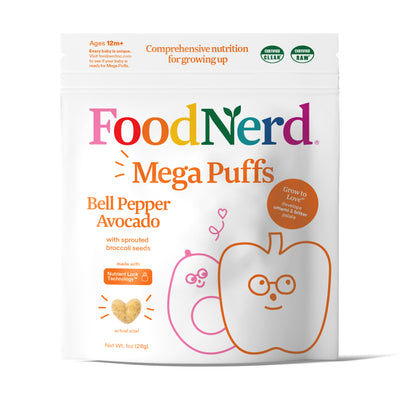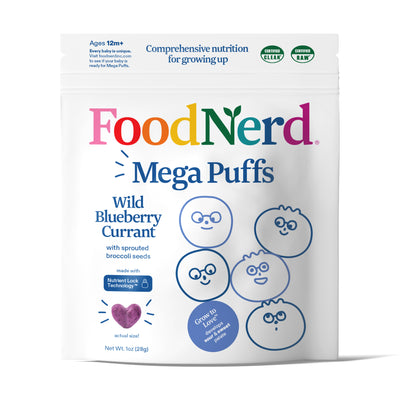The first crisp mornings of fall always feel like an invitation for fun and adventure. They’re perfect days for kiddos to stop and sniff that woodsy-sweet air before school, and for parents to slow down and make something small and lovely out of an ordinary afternoon.
At FoodNerd, we’re all about helping families bring food-first thinking into play; whether that’s with simple, nutrient-conscious snacks that travel well, or activities that turn a walk to the park into a lesson in texture, color, and curiosity. We’re always thinking about how the food we eat supports how our kids grow, but this fall, we also want to get kids moving and exploring.
Outdoor play supports physical activity and gives children room to move, explore risk safely, and try new motor skills. It’s also a powerful tool for language, self-regulation, and creative thinking.
Before we jump in: always supervise eating and crafts, cut or adapt foods for your child’s chewing ability, and avoid small, hard items that are choking hazards (nuts, whole grapes, popcorn, large chunks of raw fruit or veg). When in doubt, follow safety guidance from pediatric experts.
Below you’ll find a collection of low-mess, high-delight fall activities you can do with your little one. We’ve thought through the supplies and time you’ll need so you can plan your outing (or rainy-day living-room session) without guessing.
Clementine “mini pumpkins”
This craft is an instant delight and requires very little prep. This is a crowd-pleaser that lives at the border between snack and activity!
You will need:
- clementines or small mandarins
- short piece of celery for the stem
- optional tiny leaf of basil or mint
- small toothpicks only if your toddler is older and supervised
- A small bowl or tray to contain peels and segments helps keep it tidy.
Time: 5–12 minutes (fast — great as a “first thing” park activity).
How to do it: gently peel the clementine with your toddler. Let them pull segments off and drop the peel on the tray. Press the short celery piece into the top where a stem would sit (an adult or older toddler does the pressing). If you want a face, an adult can use a small knife to score tiny eyes or use soft-topping (yogurt + cocoa) to “dot” eyes. Serve the segments in a small cup so your child can graze while you play.
Leaf printing + nature walk (big on discovery, rich in sensory play)
This activity combines a gentle nature walk with an art project that celebrates texture and color. Leaf printing is forgiving, beautiful, and a great way to talk about shapes and veins in leaves.
You will need:
- a stack of heavy paper or cardstock (or a canvas tote to print on)
- washable finger paints or tempera in small squeeze containers
- a small roller or paintbrush, a flat tray or plate per color, wipes
- a picnic blanket, and a folder or clipboard to press prints flat to dry
- Optional: a basket for collecting leaves.
- Time: 25–45 minutes total (10–20 minutes for the walk and leaf-collecting, 15–25 minutes for printing and drying; allow extra time for curious toddlers).
How to do it: take a short walk and invite your toddler to collect interesting leaves ofdifferent sizes and textures. Back at the blanket, flatten a leaf (vein-side up) and either paint the underside (to get a vein impression) or paint the top for a fun silhouette. Press the leaf onto paper, then press with your hands or a small rolling pin so the veins print. Toddlers can press and pat; adults do the paint application if the child is likely to smear. Let prints dry on a flat surface.
Practical tip!
Use washable, non-toxic paints made for little hands (look for washable/child-safe labels). Spill-proof tubs or semi-solid “stamp” paints reduce mess and are quick to clean. After prints dry, turn a few into a keepsake “leaf book” by stapling pages together so your child can flip through their finds.
Fall sensory basket (indoor or backyard) for enriching exploration without screens
This activity is great sensory play for days when weather is iffy.
You will need:
- a shallow plastic bin
- soft pumpkin-shaped fabric toy
- a few large, open pinecones (cleaned)
- big fabric leaves
- a chunky wooden spoon
- small pot of safe “dippy” play e.g., a smear of yogurt or applesauce on a plate for finger exploration.
Avoid small nuts, seeds, or anything you don’t want in the mouth.
Time: set up 10–15 minutes; play 10–30 minutes depending on mood.
How to do it: let your toddler explore at their pace. Swap one item daily so the bin stays interesting. For toddlers under three, keep all objects large enough not to be swallowed and avoid loose small items.
Apple (or potato) stamping!
This craft is a classic. It uses simple geometry, repeatable patterns, and it’s an easy way to make homemade wrapping paper or cards.
You will need:
- halved apples or a halved potato
- washable paint
- paper or butcher paper
- a tray for paints
- Wipes
- hammer or adult tool to press the fruit if you want deeper stamp ridges.
Time: 15–30 minutes (prep 5–10, stamping 10–20).
How to do it: cut an apple in half, slice off a little so it sits flat. Let the toddler press it into paint (adult hold), then press onto paper. Try stamping in a circle to make “pumpkins,” or use green paint to stamp little stems. Keep a damp cloth handy for sticky hands.
Safety note: apples used for stamping should not be eaten afterward unless you kept everything food-safe and the paints are non-toxic and labeled safe for skin/food contact; otherwise, serve fresh food separately.
Leaf garland
This craft can be paired with your nature walk for a prize you can hang up that day. Plus it is a great way to practice fine motor skills!
You will need:
- pre-punched paper leaves or real large leaves taped to paper
- yarn or wide ribbon
- large plastic needle (child-safe) or a small straw (thin coffee straw)
- clothespins or tape.
Time: 20–30 minutes (may stretch longer if your toddler enjoys threading).
How to do it: pre-punch holes in leaves so your toddler can thread with ease, or use clothespins to clamp leaves to a long ribbon. This is great for very young children who aren’t threading yet.
Tip: adapt for younger toddlers by using clothespins. Squeezing builds hand strength!
Quick snack-decorating station
We think food as play makes everyday fun. With a snack station, snack time becomes creative and teaches your little one food handling, and doubles as fine motor practice.
You will need:
- apple slices (softened or thinly sliced for older toddlers)
- yogurt or nut/seed butter spread thinly, small bowls of mix-ins (FoodNerd Puffs, anyones??)
- Use resealable packs for on-the-go crisps that add crunch without refrigeration.
Time: 10–15 minutes (short, focused, and often followed by a snack).
Pumpkin patch or apple picking
Nothing says fall like a trip through a pumpkin patch or reaching up for apples. It’s outdoor movement and it ends with a tangible food prize you can cook or play with later. Local farms often offer extras like wagon rides, corn mazes, or kid-friendly animal areas.
You will need:
- weather-appropriate layers
- sturdy shoes (patches can be muddy!)
- reusable bag or small basket
- wipes for sticky apple hands
- Water
- cooler bag in the car if you’re taking fruit or pumpkins home. Many orchards will have bags, but toddlers love carrying their own lightweight basket.
- Time: 1–2 hours (shorter if your toddler tires easily; you can always explore a bit and head home with a single pumpkin or a couple of apples).
How to do it: let your toddler pick their own pumpkin (choose a size they can lift, even if it’s tiny). For apple picking, show them how to “twist and lift” instead of pulling. Keep expectations low, they may only pick a handful before wanting to explore something else. End with a short snack on a hay bale or blanket. Once home, use apples for simple toddler-friendly snacks, maybe thin slices with a light spread of seed butter, or stewed into quick applesauce or turn a pumpkin into a sensory bin before cooking it down into puree. It connects the “big day out” to a meaningful kitchen moment.
Most importantly, enjoy!
As the days get shorter and the air turns crisp, rituals like peeling a clementine “pumpkin,” crunching through leaves on a nature walk, or hauling home the tiniest apple-picking prize add up to something bigger. They build traditions. Whether you’re crafting at the kitchen table or wandering through a pumpkin patch, fall is full of opportunities to weave food, play, and curiosity together without complicated prep required. Here’s to sticky fingers, muddy boots, and memories you’ll both carry long after the leaves have fallen.















